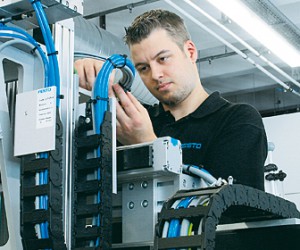Addressing the effects of high-level automation in factories on the employment environment in South Africa.
Factory, along with process automation has developed increasingly, with smart machines rapidly changing the industry. Within certain key industry sectors the development trend is gradually moving away from semi-automated processes towards highly automated production lines on which only a small number of work operations are required. This has inevitably raised concerns regarding the effects this will have on employment levels within factories.
One of the key questions has been whether or not these smart machines are replacing people. If this is the case, are these employees losing their jobs to make way for these machines – leading to increased levels of unemployment in factories? These questions need to be addressed in order to avoid negative and incorrect assumptions being made across the board.
In order for businesses to remain globally competitive, they have to get on board with increased levels of automation. High-level automation allows for increased productivity and consequently output, but does not necessarily do this at the expense of employees.
“That said it remains important that we remain on top of these concerns and do all we can to ensure that employees benefit equally from this movement towards the future,” says Brett Wallace, Deputy General Manager of Festo South Africa.
“Plans need to be put in place and implemented to allow for synergy between the increased usage of smart machines and the simultaneous success of factory employees. The importance is making sure that employees are fully involved in the process of change in order to come up with company-specific solutions that benefit everyone.”
Wallace also points out that manufacturers must implement change management in such a way that employees who worked on the previous semi-automated lines are redeployed on other lines.
“The industry growth we are seeing of highly automated factories is allowing for exciting and promising developments when it comes to employment. High-level automation eliminates repetitive jobs, allowing for more time to be devoted to skills development and training. Smart machines increase efficiency in the workplace but people are still needed.”
“In order to prevent employees from losing their jobs in production processes, there are a number of things highly automated factories can do. As has been mentioned, eliminating manual, mindless and repetitive tasks allows for employees to be redeployed to areas that are better suited to their skills. With the correct training and development, these employees can become highly skilled and specialised, adding value not only to the company they work for, but to their work on an individual level.”
“The increased productivity that results from high-level automation makes room for creating higher paying jobs and the hiring of already-skilled employees that can assist in development and training. In this vein, not enough emphasis can be put on training and development. The core focus needs to be on the empowerment of employees and creating opportunities for them, especially through up-skilling.”
Education and training needs to be of highest priority in the development towards highly automated factories. “We must be committed to being more than the engineers of smart machines. It is important to ensure that, in going forward, plans and programmes are put in place to not only retain employees, but further them,” says Wallace.
It is important that the concerns surrounding high-level automation and the impact it has on employment should be actively addressed – in doing so, proactive solutions will be created for an industrial future that is beneficial for all.
“It is our firm belief that by maintaining this stance and focusing on the creation of opportunities through education and training, high-level automation will not just take industry productivity to new heights, but the workforce as well,” concludes Wallace.
Vickie Oosthuizen






